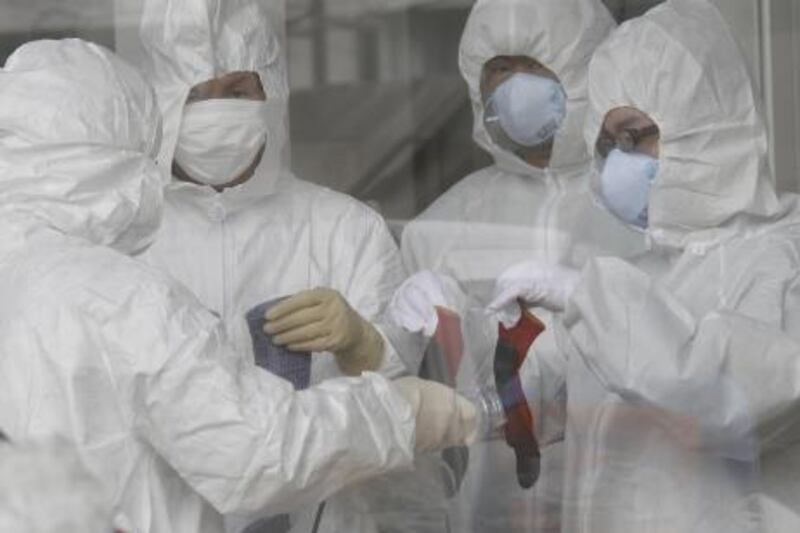FUKUSHIMA, JAPAN // Japan ordered emergency workers to withdraw from its stricken nuclear plant early on Wednesday amid a surge in radiation, temporarily suspending efforts to cool the overheating reactors.
Yukio Edano, the chief cabinet secretary, said the workers, who have been dousing the reactors with seawater in a frantic effort to stabilise their temperatures, had no choice but to pull back from the most dangerous areas.
"The workers cannot carry out even minimal work at the plant now," Edano said, as smoke billowed above the crippled Fukushima Dai-ichi nuclear complex. "Because of the radiation risk we are on standby."
The nuclear crisis has triggered international alarm and partly overshadowed the human tragedy caused by Friday's 9.0-magnitude earthquake and the subsequent tsunami, a blast of black seawater that pulverised Japan's north-eastern coastline. The quake was one of the strongest recorded in history.
Later on Wednesday, officials said they were considering using helicopters to dump water onto the most troubled reactors in a desperate effort to cool them down.
But Mr Edano has already warned that may not work.
"It's not so simple that everything will be resolved by pouring in water. We are trying to avoid creating other problems," he said.
"We are actually supplying water from the ground, but supplying water from above involves pumping lots of water and that involves risk. We also have to consider the safety of the helicopters above."
Radiation levels had gone down by later on Wednesday, but it was not immediately clear if the workers had been allowed back in, or how far away they had withdrawn. The team of workers - a core team of 70 - had been regularly rotated in and out of the danger zone to minimise their radiation exposure.
Meanwhile, officials in Ibaraki prefecture, just south of Fukushima, said radiation levels were about 300 times normal levels by late morning. While those levels are unhealthy for prolonged periods, they are far from fatal.
Days after Friday's twin disasters, millions of people were struggling along the coast with little food, water or heat, and already chilly temperatures dropped further as a cold front moved in. Up to 450,000 people are staying in temporary shelters, often sleeping on the floor of school gymnasiums.
More than 11,000 people are officially listed as dead or missing, but most officials believe the final death toll will be well over 10,000 people.
Since the quake and wave hit, authorities have been struggling to avert an environmental catastrophe at the Fukushima Dai-ichi complex, 220 kilometres north of Tokyo. The tsunami knocked out the backup diesel generators needed to keep nuclear fuel cool, setting off the atomic crisis.
Wednesday's radiation spike was apparently the result of a release of pressure that had built up in the complex's Unit 2 reactor, officials said. Steam and pressure build up in the reactors as workers try to cool the fuel rods, leading to controlled pressure releases through vents - as well as uncontrolled explosions.
A US nuclear expert said he feared the worst.
"It's more of a surrender," said David Lochbaum, a nuclear engineer who now heads the nuclear safety programme for the Union of Concerned Scientists, an activist group. "It's not like you wait 10 days and the radiation goes away. In that 10 days things are going to get worse.
"It's basically a sign that there's nothing left to do but throw in the towel."
Mr Edano said the government expects to ask the US military for help, though he did not elaborate. He said the government is still considering whether to accept offers of help from other countries.
The government has ordered some 140,000 people in the vicinity to stay indoors. A little radiation was also detected in Tokyo, triggering panic buying of food and water.
There are six reactors at the plant. Units 1, 2 and 3, which were operating last week, shut down automatically when the quake hit. Since then, all three have been rocked by explosions. Compounding the problems, on Tuesday a fire broke out in Unit 4's fuel storage pond, an area where used nuclear fuel is kept cool, causing radioactivity to be released into the atmosphere.
Units 4, 5 and 6 were shut at the time of the quake, but even offline reactors have nuclear fuel - either inside the reactors or in storage ponds - that need to be kept cool.





